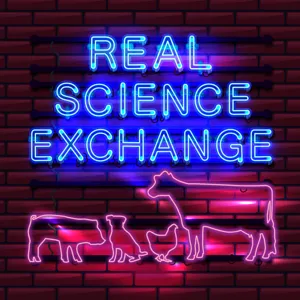2022 Journal Club September

Guests: Dr. Bill Weiss, The Ohio State University
Co-host: Dr. Clay Zimmerman and Dr. Glen Aines
Diving into two recent Journal of Dairy Science publications, Dr. Bill Weiss, Emeritus Professor at Ohio State University is back again to discuss the latest ideas and trends in animal nutrition.
Dr. Weiss highlights two papers published in the Journal of Dairy Science earlier this year, adding one is focused on production while the other highlights fermentation digestibility. One key point Dr. Weiss highlighted was the controversial discussion around supplementing molasses or sugar. 3:02
Dr. Clay Zimmerman with Balchem also joined the evening discussion, adding that currently it is common to add a liquid sugar source for a certain level of sugar to optimize microbial protein synthesis. 6:02
Diving into the first paper, Dr. Weiss suggested the positive response to molasses would be affected by the RDP (Ratio Degradable Protein), adding he believes this was a valid hypothesis. He went on to highlight fiber differences, digestibility measures and the impact of inputting the data into the NRC (National Research Council) old database. 9:09
Analyzing a few key conclusions and surprises from the first production study, Dr. Weiss pointed out his thoughts on the milk efficiency components and intake digestibility results. 16:04
On the 10-week intake study, Dr. Zimmerman noted the results showed cows were on a two-week covariate diet and then eight weeks on the treatment diet, plus adding in high moisture corn as a grain source. Additionally, he added the only key parameter that wasn’t negatively affected by the increasing molasses was fat. 24:26
In fact, Dr. Glen Aines with Balchem, who also joined in on the conversation, was surprised the journal cited about 42% of VFA’s coming out of the molasses due to the belief it will produce less acidosis. 29:16
In the second paper, Dr. Weiss mentioned the results of no impact to RDP (Ratio Degradable Protein) from the models. Dr. Weiss added if he expects the diets to be deficient in RDP, he would also expect increased intake and digestibility. 31:16
No models are ever perfect, so analyzing the results from any study is essential.
Dr. Aines reflected on key takeaways from the second paper, highlighting the different fermentation battens between the various treatments and microbial population shifts. 49:54
Rounding out the conversation, Dr. Weiss closed suggesting the understanding that nothing works all the time and that’s why replicating experiments is so important. 53:41
If you want one of our new Real Science Exchange t-shirts, screenshot your rating, review, or subscription, and email a picture to anh.marketing@balchem.com. Include your size and mailing address, and we’ll get a shirt in the mail to you.
Please subscribe and share with your industry friends to bring more people to join us around the Real Science Exchange virtual pub table.
Links to Papers:
https://www.sciencedirect.com/science/article/pii/S0022030222001874